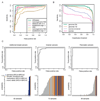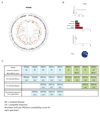HRDetect is a predictor of BRCA1 and BRCA2 deficiency based on mutational signatures
- PMID: 28288110
- PMCID: PMC5833945
- DOI: 10.1038/nm.4292
HRDetect is a predictor of BRCA1 and BRCA2 deficiency based on mutational signatures
Abstract
Approximately 1-5% of breast cancers are attributed to inherited mutations in BRCA1 or BRCA2 and are selectively sensitive to poly(ADP-ribose) polymerase (PARP) inhibitors. In other cancer types, germline and/or somatic mutations in BRCA1 and/or BRCA2 (BRCA1/BRCA2) also confer selective sensitivity to PARP inhibitors. Thus, assays to detect BRCA1/BRCA2-deficient tumors have been sought. Recently, somatic substitution, insertion/deletion and rearrangement patterns, or 'mutational signatures', were associated with BRCA1/BRCA2 dysfunction. Herein we used a lasso logistic regression model to identify six distinguishing mutational signatures predictive of BRCA1/BRCA2 deficiency. A weighted model called HRDetect was developed to accurately detect BRCA1/BRCA2-deficient samples. HRDetect identifies BRCA1/BRCA2-deficient tumors with 98.7% sensitivity (area under the curve (AUC) = 0.98). Application of this model in a cohort of 560 individuals with breast cancer, of whom 22 were known to carry a germline BRCA1 or BRCA2 mutation, allowed us to identify an additional 22 tumors with somatic loss of BRCA1 or BRCA2 and 47 tumors with functional BRCA1/BRCA2 deficiency where no mutation was detected. We validated HRDetect on independent cohorts of breast, ovarian and pancreatic cancers and demonstrated its efficacy in alternative sequencing strategies. Integrating all of the classes of mutational signatures thus reveals a larger proportion of individuals with breast cancer harboring BRCA1/BRCA2 deficiency (up to 22%) than hitherto appreciated (∼1-5%) who could have selective therapeutic sensitivity to PARP inhibition.
Conflict of interest statement
H. Davies, D. Glodzik and S. Nik-Zainal are inventors on a patent application encompassing the code and intellectual principle on this algorithm. A. Tutt has been in receipt of payments from the Institute of Cancer Research Rewards to inventors scheme associated with the invention of PARP inhibitors as therapy for
Figures


Initial training using 22 known germline BRCA1 and BRCA2 null samples.
Retraining using 77 BRCA1 and BRCA2 null samples to produce the final HRDetect predictor.
Validation on a further set of breast cancers and application to other data sets.



References
-
- John EM, et al. Prevalence of pathogenic BRCA1 mutation carriers in 5 US racial/ethnic groups. JAMA. 2007;298:2869–76. - PubMed
-
- Malone KE, et al. Prevalence and predictors of BRCA1 and BRCA2 mutations in a population-based study of breast cancer in white and black American women ages 35 to 64 years. Cancer Res. 2006;66:8297–308. - PubMed
-
- King MC. "The race" to clone BRCA1. Science. 2014;343:1462–5. - PubMed
MeSH terms
Substances
Grants and funding
LinkOut - more resources
Full Text Sources
Other Literature Sources
Medical
Miscellaneous

